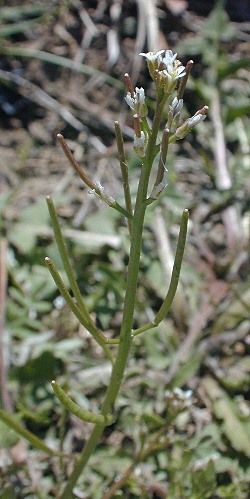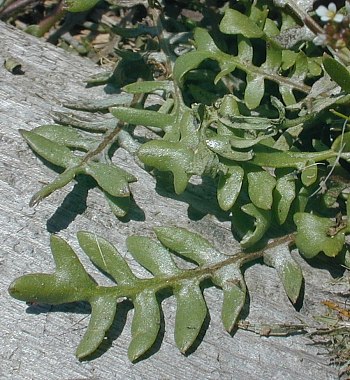 Description:
This winter
annual consists of a low-growing rosette of leaves up to 1' across,
from which there develops one or more flowering stalks up to 1½' tall.
The basal leaves are up to 6" long and 2" across, deeply pinnatifid,
hairless, and somewhat succulent. The upper surface of these leaves is
green or slightly reddish green and glabrous (sometimes powdery white
patches are present, although this may be powdery mildew). Some of the
lobes have 1 or 2 blunt teeth and secondary lobes. The flowering stalks
can be erect or sprawl across the ground, and they are green to
brownish red. Each of these stalks has a raceme of tiny flowers at the
top, while toward the base there are a few spreading white hairs and no
leaves. Each flower is about 1/10" across and consists of 4 white
petals, 4 green or reddish green sepals, a central pistil, and a few
stamens. The sepals are erect and lanceolate. The pedicel of each
flower is about ½" long. The blooming period occurs from early to late
spring and lasts about a month. Each flower is replaced by a hairless
silique (a long narrow seedpod) about 1" long that is semi-erect. This
silique lacks a stipe or beak and contains a single row of seeds. Each
seed is circular, somewhat flattened, and has a narrow papery wing
along its outer margin. The seeds are distributed, at least in part, by
the wind. The root system consists of a taproot. This plant spreads by
reseeding itself.
Description:
This winter
annual consists of a low-growing rosette of leaves up to 1' across,
from which there develops one or more flowering stalks up to 1½' tall.
The basal leaves are up to 6" long and 2" across, deeply pinnatifid,
hairless, and somewhat succulent. The upper surface of these leaves is
green or slightly reddish green and glabrous (sometimes powdery white
patches are present, although this may be powdery mildew). Some of the
lobes have 1 or 2 blunt teeth and secondary lobes. The flowering stalks
can be erect or sprawl across the ground, and they are green to
brownish red. Each of these stalks has a raceme of tiny flowers at the
top, while toward the base there are a few spreading white hairs and no
leaves. Each flower is about 1/10" across and consists of 4 white
petals, 4 green or reddish green sepals, a central pistil, and a few
stamens. The sepals are erect and lanceolate. The pedicel of each
flower is about ½" long. The blooming period occurs from early to late
spring and lasts about a month. Each flower is replaced by a hairless
silique (a long narrow seedpod) about 1" long that is semi-erect. This
silique lacks a stipe or beak and contains a single row of seeds. Each
seed is circular, somewhat flattened, and has a narrow papery wing
along its outer margin. The seeds are distributed, at least in part, by
the wind. The root system consists of a taproot. This plant spreads by
reseeding itself.
Cultivation:
The preference is full sun, mesic to dry conditions, and poor soil that
contains clay, sand, or rocky material. Most vegetative growth occurs
during the early to mid-spring. This plant can grow on fertile loamy
soil if competition from other plants is reduced (for example, by
occasional mowing). It can invade lawns, particularly where turf grass
is sparse or absent.
Range & Habitat:
Virginia Rock Cress occurs occasionally in the southern half of
Illinois, while in the northern half of the state it is uncommon or
absent (see Distribution
Map). This plant has been spreading northward and it may be
more common in some disturbed areas than in the past. It is native to
southern Illinois, and probably adventive from the south elsewhere.
Habitats include openings in rocky woodlands, fields and pastures,
yards and edges of sidewalks, nursery plots with sandy ground,
roadsides, and sterile waste areas.
Faunal Associations:
The flowers provide an early source of nectar and pollen to flower
flies, although they appear to have few insect visitors. The
caterpillars of a few species of moths and Pierid butterflies may feed
on the foliage.
Photographic Location:
In a yard along the border of a sidewalk in Urbana, Illinois.

Comments: An older scientific name for Virginia Rock Cress is Arabis virginica. It has since been reassigned to its own genus, Sibara, which is simply 'Arabis' spelled backward. This is one of the few annual plants in the Mustard family that is native to North America, rather than introduced from Eurasia. The species in this large family are often hard to tell apart. Like the similar Arabis spp. (Rock Cresses), Virginia Rock Cress has white flowers with 4 petals, siliques without stipes or beaks, and seeds with winged margins. It differs from the Rock Cresses in being a rather weedy annual plant rather than a more conservative perennial. Some distinctive features of Virginia Rock Cress include the tiny size of the flowers (only 1/10" or 2.5 mm. across) and its deeply pinnatifid leaves. It is glabrous, except for a few hairs at the base of the flowering stems, and its siliques are semi-erect. Other Rock Cresses tend to have larger flowers and hairier leaves that are less deeply lobed. Their siliques may be appressed close to the flowering stalk like Arabis glabra (Tower Mustard), or they may be widely spreading and rather floppy like Arabis canadensis (Sicklepod).